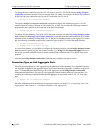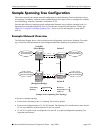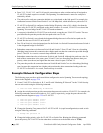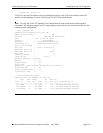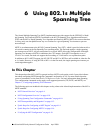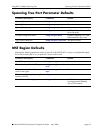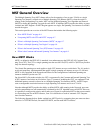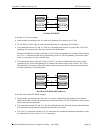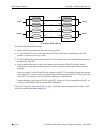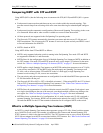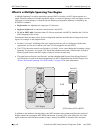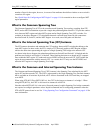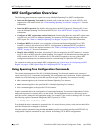
MST General Overview Using 802.1s Multiple Spanning Tree
page 6-4 OmniSwitch 6600 Family Network Configuration Guide April 2006
MST General Overview
The Multiple Spanning Tree (MST) feature allows for the mapping of one or more VLANs to a single
Spanning Tree instance, referred to as a Multiple Spanning Tree Instance (MSTI), when the switch is
running in the flat Spanning Tree mode. MST uses the Multiple Spanning Tree Algorithm and Protocol
(MSTP) to define the Spanning Tree path for each MSTI. In addition, MSTP provides the ability to group
switches into MST Regions. An MST Region appears as a single, flat Spanning Tree instance to switches
outside the region.
This section provides an overview of the MST feature that includes the following topics:
• “How MSTP Works” on page 6-4.
• “Comparing MSTP with STP and RSTP” on page 6-7
• “What is a Multiple Spanning Tree Instance (MSTI)” on page 6-7.
• “What is a Multiple Spanning Tree Region” on page 6-8.
• “What is the Internal Spanning Tree (IST) Instance” on page 6-9.
• “What is the Common and Internal Spanning Tree Instance” on page 6-9.
How MSTP Works
MSTP, as defined in the IEEE 802.1s standard, is an enhancement to the IEEE 802.1Q Common Span-
ning Tree (CST). The CST is a single spanning tree that uses 802.1D (STP) or 802.1w (RSTP) to provide a
loop-free network topology.
The Alcatel flat spanning tree mode applies a single CST instance on a per switch basis. The 1x1 mode is
an Alcatel proprietary implementation that applies a single spanning tree instance on a per VLAN basis.
MSTP is only supported in the flat mode and allows for the configuration of additional spanning tree
instances instead of just the one CST.
On Alcatel 802.1s flat mode switches, the CST is represented by the Common and Internal Spanning Tree
(CIST) instance 0 and exists on all switches. Up to 17 instances, including the CIST, are supported. Each
additional instance created is referred to as a Multiple Spanning Tree Instance (MSTI). An MSTI repre-
sents a configurable association between a single Spanning Tree instance and a set of VLANs.
Note that although MSTP provides the ability to define MSTIs while running in the flat mode, port state
and role computations are still automatically calculated by the CST algorithm across all MSTIs. However,
it is possible to configure the priority and/or path cost of a port for a particular MSTI so that a port remains
in a forwarding state for an MSTI instance, even if it is blocked as a result of automatic CST computa-
tions for other instances.
The following diagrams help to further explain how MSTP works by comparing how port states are deter-
mined on 1x1 STP/RSTP mode, flat mode STP/RSTP, and flat mode MSTP switches.



